Knedlíky are traditional Czech dumplings which use a dough similar to bread dough. They're boiled and sliced, and served with a variety of traditional Czech dishes. If you enjoy Czech food, make this authentic recipe!
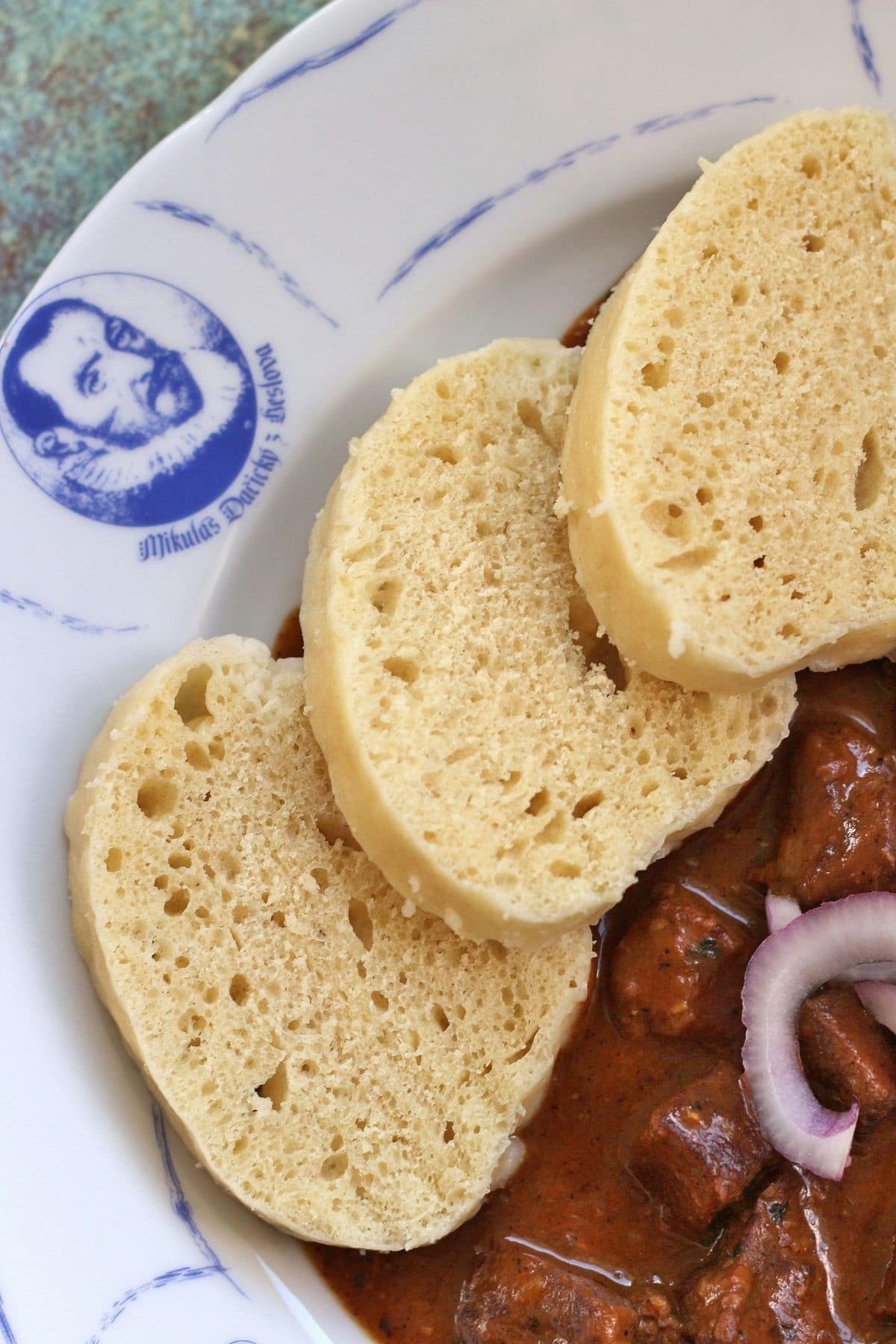
Czech cuisine is considerably humble, with influences from surrounding countries. Much of Czech cuisine consists of comforting recipes for soups, stews, and meat dishes (namely pork, beef, and poultry including game birds). Furthermore, Czech dumplings are a popular counterpart to many meals.
There are many different ways to make traditional Czech dumplings, or knedlíky.
One version is bread dumplings, or houskový knedlíky, which uses a combination of diced stale bread bound together with flour, milk, eggs, and leavening. It is sometimes also called knedlo, knödel, kniddel, and canederli depending on the country or culture of origin including the likes of Germany, Austria, Poland, Hungary and even Italy.
Another, bramborové knedlíky or potato dumplings, features mashed potatoes, eggs, flour, sometimes butter or other ingredients. Versions of these dumplings are also common is some of the surrounding countries.
You can also make Czech dumplings using a type of bread dough. This is the version of knedlíky we'll explore for this recipe.
Ingredient notes
This recipe for knedlíky uses a dough very similar to typical bread dough. It uses yeast for leavening and is enriched with milk. It uses a coarser instant or quick-mixing flour that is different from all-purpose or bread flour. The availability of this flour can range in different parts of the world, but here are some options for acceptable flours you can use for this recipe.
- United States: Wondra flour (by Gold Medal brand)
- Czech Republic: Hrubá mouka
- Canada: Robin Hood Easy Blend
- Australia: Continental flour (any brand)
- Germany: Aurora Instant Mehl Type 405 or any Spätzlemehl
Instant flour is a low-protein, finely ground wheat flour which has been pre-cooked and dried. You can use leftover instant or quick-mixing flour to thicken gravies and sauces. If you live in any other countries, try to find a type of flour with similar qualities, or see if you can order one of the above types of flour online. You cannot simply substitute all-purpose flour for the instant flour because the texture and consistency will not be the same.
These Czech dumplings use dry active yeast for the recipe. I have not tested it with different types of yeast, however I will provide general substitution guidelines in case you need to try them.
- Instant yeast: reduce the amount of yeast by 25% and mix the yeast directly into the flour mixture. Proceed with the recipe as directed.
- Fresh yeast: double the amount of yeast and crumble it into your warm milk mixture. Proceed with the recipe as directed.
Once again, these are only general guidelines for substituting yeast. I have not made this recipe with instant or fresh yeast, but am providing these steps just in case you need them.
This recipe uses kosher salt (aka cooking salt, kitchen salt, coarse salt outside of the US). If you are using table salt, you can scale down the salt as that is a saltier type of salt by volume! You will also be salting the water for cooking these dumplings so there is an opportunity to add more salt later when they cook.
How to make them
Begin by combining the warm milk, sugar, and yeast in a medium mixing bowl. Let it bloom for about 10 minutes. Beat the egg into the milk mixture.
Next, combine the flour and salt in a large mixing bowl, stir in the milk and egg mixture, and knead together for a few minutes until smooth. The dough can be a bit tacky but shouldn't be very sticky. If it's sticky, add a bit more flour as needed. Cover with a towel and let it rise in a warm spot for 2 hours or until doubled in size (PHOTOS 1-2).
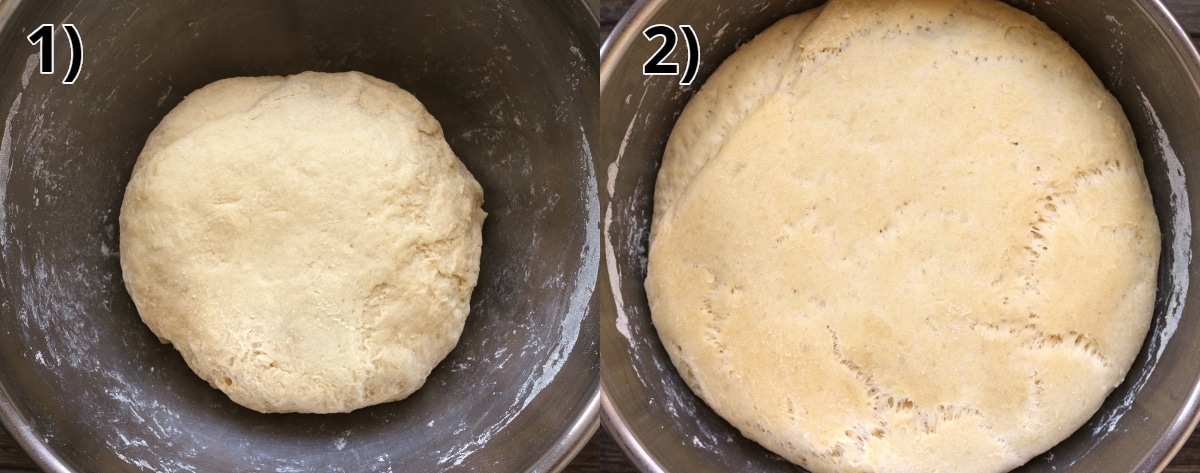
Cut the dough into thirds, and shape each piece of dough into a 2-inch thick rope. I like using a digital scale to divide my dough into equal sized pieces, but you can eyeball it if you don't have a scale. You may or may not need to flour your work surface depending on if you dough is a bit sticky or not.
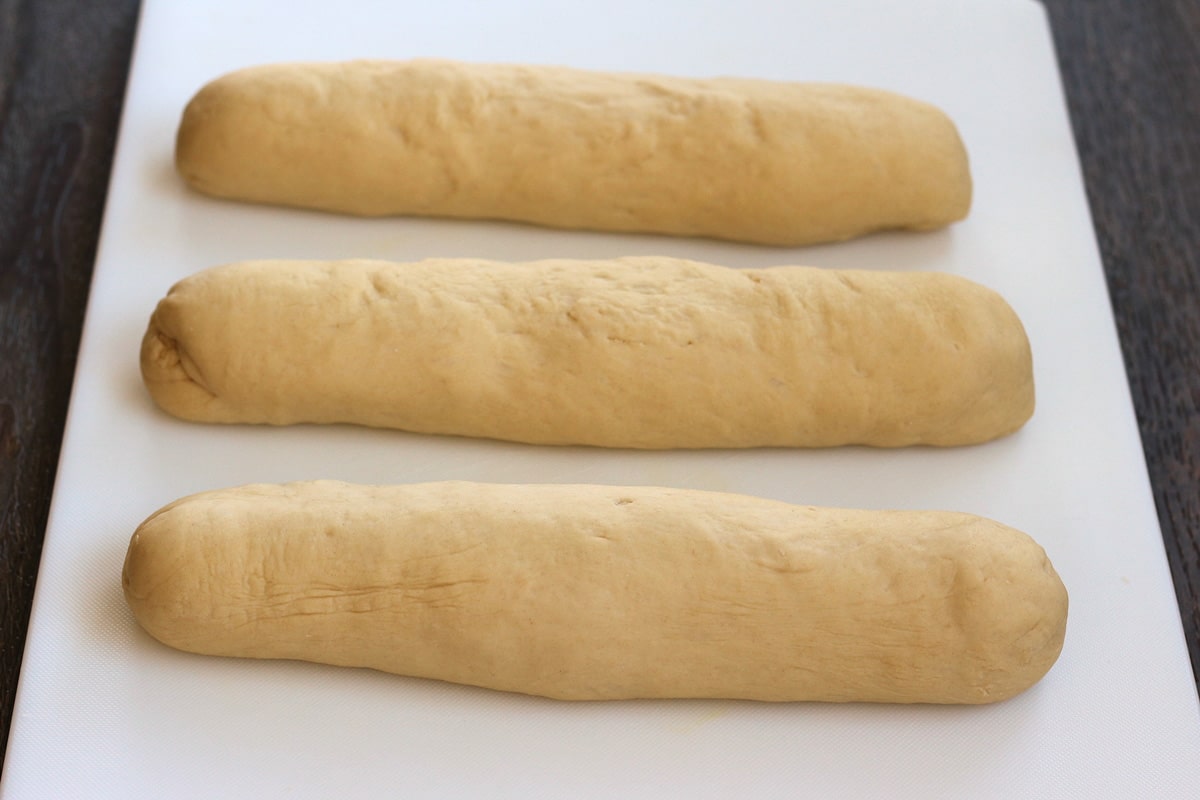
Cover with a towel, and let the shaped dumplings rise for 15 minutes. Meanwhile, select a pot that is at least 10-inches wide and deep enough to boil water. Add water and salt and bring to a boil. Boil the dumplings uncovered for 20 minutes flipping them over halfway through. The dumplings will expand quite a bit (PHOTOS 3-4).
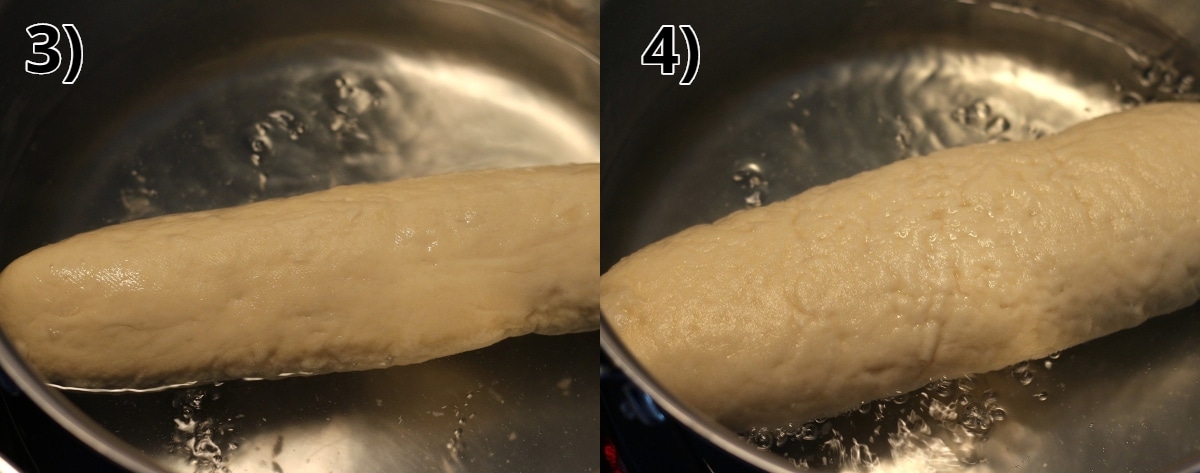
If they don’t all fit in your pan at once, cook them in batches. I cook mine one at a time, so it can be time consuming (a full hour to cook all 3 dumplings) but it's not very hands on. Set a timer for 10 minutes, then flip. Set your timer for another 10 minutes, then remove. Easy peasy.
After removing from the boiling water with a large slotted spoon or spatula, immediately poke them with a toothpick in a few spots to let the steam out. Cool for at least 5 minutes before slicing with a serrated knife, thread, or dental floss into about ¾-inch-thick slices.
I find that these dumplings are fine at room temperature for a while before serving them. Mine have sat out for an hour or longer before I served them with dinner. Cover them so they don't dry out if you aren't going to serve them immediately. You can also store them and heat them up again at a later time.
Please scroll to the bottom of the post for the full recipe (in a printable recipe card) including ingredient amounts and detailed instructions.
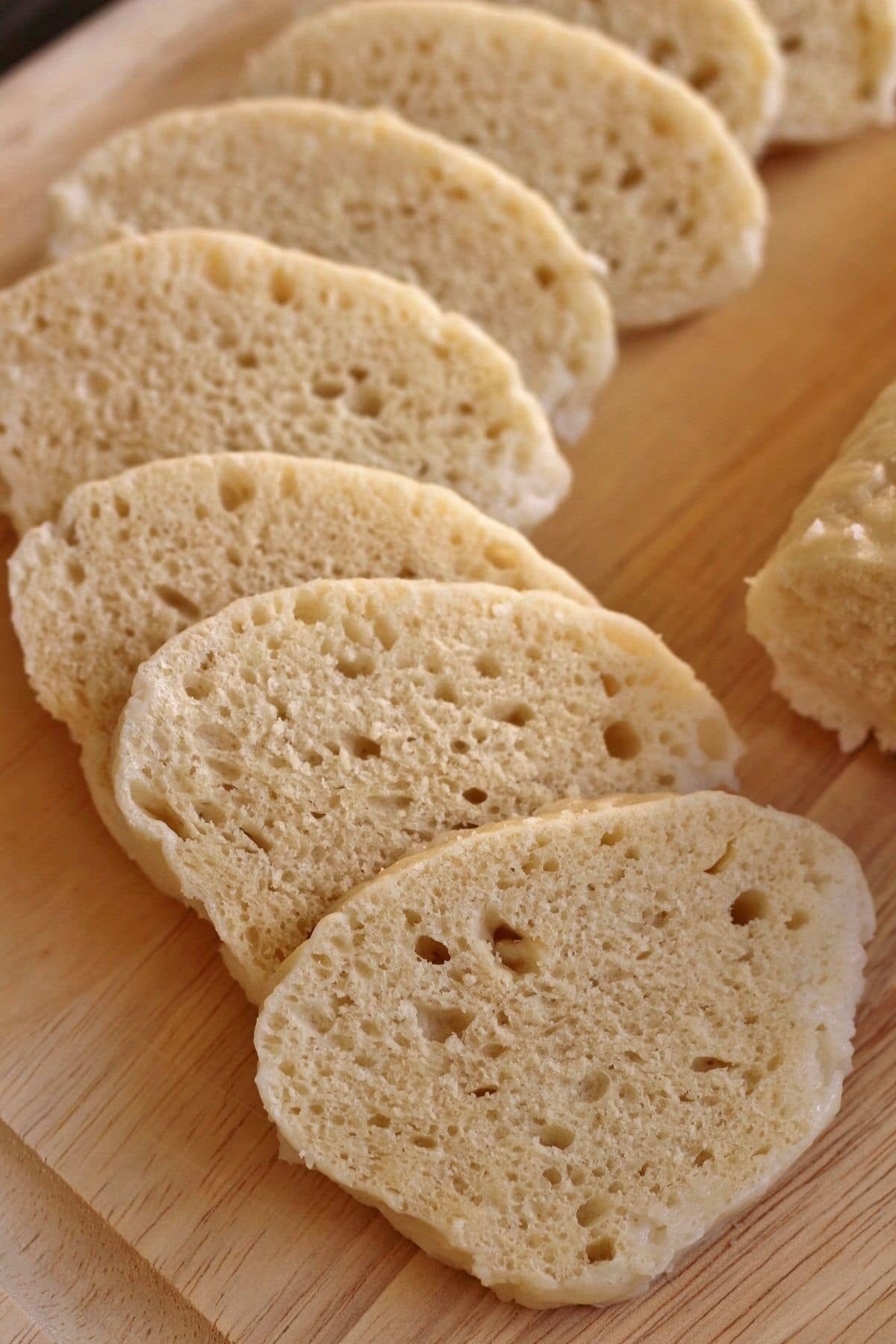
How to store and reheat them
Cool dumplings completely, wrap them in aluminum foil or plastic wrap, then place in freezer bags into the refrigerator or freezer. You can refrigerate dumplings for several days, or freeze them for longer (about 3 to 6 months since they are basically bread). You will definitely need to reheat/refresh the dumplings before serving.
If previously frozen, thaw dumplings completely (preferably overnight in the refrigerator) and slice them into portions.
Steaming is the best way to reheat your Czech dumplings. Add a little water to a pot and place a steamer basket over the top. Heat it on high heat, then once you hear the water boiling, lower the heat so it’s more of a gentle simmer. Arrange sliced dumplings on the perforated steamer, cover, and steam for 2 to 3 minutes until heated through.
As a backup option, you can also wrap the dumplings with a damp paper towel, put them on a plate and microwave for about 30 seconds until softened and heated through.
What to serve with these dumplings
Czech dumplings are soft and slightly chewy with a spongy quality that is great at soaking up sauces and gravies on your plate. Knedlíky are traditionally served with roasted meats like pork, goose, or duck, or saucy stews and roasts like Czech beef goulash (hovězí guláš) and Czech marinated roast beef with creamy vegetable sauce (svíčková).
Honestly, I just think of them as spongy bread and would use them as such. If it's got some delicious drippings or a luscious gravy, serve it with knedlíky!

Other Czech recipes you may like
- Česnečka (Czech Garlic Soup aka Hangover Soup)
- Hovězí Guláš (Czech Beef Goulash)
- Nakládaný Hermelín (Czech Marinated Cheese)
- Obložené Chlebíčky (Czech Open-Faced Sandwiches)
- Perníčky (Czech Gingerbread Cookies)
This recipe for Czech dumplings looks and tastes EXACTLY like the knedlíky I enjoyed on my trip to Prague and the Czech Republic. Definitely make this recipe if you've ever wanted to make authentic Czech dumplings!
Tried this recipe? Please leave a star ⭐️⭐️⭐️⭐️⭐️ rating in the recipe card below and/or a review in the comments section further down the page. You can also follow me on social media on Facebook, Instagram, and Pinterest!
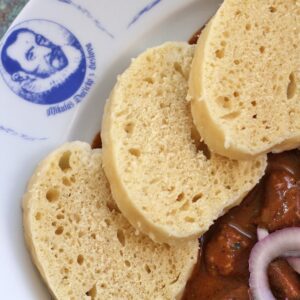
Knedlíky (Czech Dumplings)
Ingredients
- 1 ½ cups milk (warm to the touch)
- 1 teaspoon granulated sugar
- 1 teaspoon dry active yeast
- 1 large egg
- 4 ¾ cups (635 grams) quick-mixing or instant flour (such as Wondra flour; see notes for alternatives and tips on measuring)
- 1 ½ teaspoons kosher salt
Instructions
- Combine the warm milk, sugar, and yeast. Let it bloom for about 10 minutes. Beat the egg into the milk mixture. Combine the flour and salt in a large mixing bowl, stir in the milk and egg mixture, and knead together for a few minutes until smooth. The dough can be a bit tacky but shouldn't be sticky. If it's sticky, add a bit more flour as needed. Cover with a towel and let it rise in a warm spot for 2 hours or until doubled in size.
- Cut the dough into thirds, and shape each piece of dough into a 2-inch thick rope. Cover with a towel, and let the shaped dumplings rise for 15 minutes.
- Meanwhile, in a large pot (at least 10-inches wide), bring salted water to a boil. Boil the dumplings uncovered for 20 minutes flipping them over halfway through. They will expand quite a bit. If they don’t all fit in your pan at once, cook them in batches. Note that if you do need to cook them in batches, plan for 1 hour total cooking time.
- After removing from the boiling water with a large slotted spoon or spatula, immediately poke them with a toothpick in a few spots to let the steam out. Cool for at least 5 minutes before slicing with a serrated knife, thread, or dental floss into about ¾-inch-thick slices.
Notes
- Wondra flour is a type of quick mixing or instant flour by Gold Medal brand available in the United States. It is more coarse than regular all-purpose flour. Here are some alternatives for flours you can try for making these in other countries. These flours vary in weight and absorption so start with a bit less flour and add more as needed.
- Czech Republic: Hrubá mouka
- Canada: Robin Hood Easy Blend
- Australia: Continental flour (any brand)
- Germany: Aurora Instant Mehl Type 405 or any Spätzlemehl
- When in doubt, measuring by weight is always preferable to measuring by volume. The conversion of Wondra flour in this recipe from cups to grams is accurate (both by testing and also confirming the conversion on the Wondra packaging which states that ¼ cup = 30 grams). If you're measuring by volume and your dumplings turn out dry, you are packing too much flour into your cups. Spoon flour into the cup and level off the top for the best results, or better yet weigh it with a digital scale.
- This recipe uses dry active yeast. I have not tested this recipe with different types of yeast, however I will provide general substitution guidelines in case you need to try them.
- Instant yeast: reduce the amount of yeast by 25% and mix the yeast directly into the flour mixture. Proceed with the recipe as directed.
- Fresh yeast: double the amount of yeast and crumble it into your warm milk mixture. Proceed with the recipe as directed.
- To store: cool cooked dumplings completely, wrap them in aluminum foil or plastic wrap, then place in freezer bags into the refrigerator or freezer. You can refrigerate dumplings for several days, or freeze them for longer (about 3 to 6 months since they are basically bread). You will definitely need to reheat/refresh the dumplings before serving.
- To reheat: thaw dumplings completely (preferably overnight in the refrigerator) and slice them into portions. Add a little water to a pot and place a steamer basket over the top. Heat it on high heat, then once you hear the water boiling, lower the heat so it’s more of a gentle simmer. Arrange sliced dumplings on the perforated steamer, cover, and steam for 2 to 3 minutes until heated through. As a backup option, you can also wrap the dumplings with a damp paper towel, put them on a plate and microwave for about 30 seconds until softened and heated through.
Nutrition
*All nutritional information is based on third-party calculations and should be considered estimates. Actual nutritional content will vary with brands used, measuring methods, portion sizes and more.*

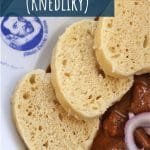
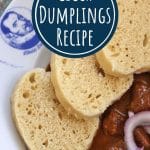
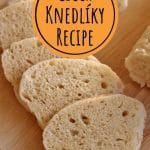
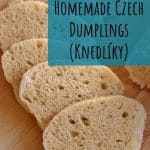
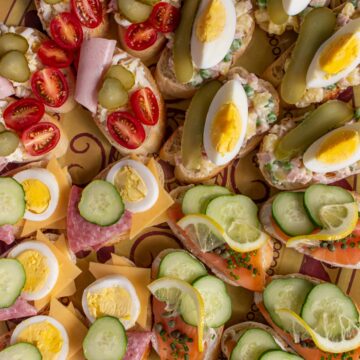
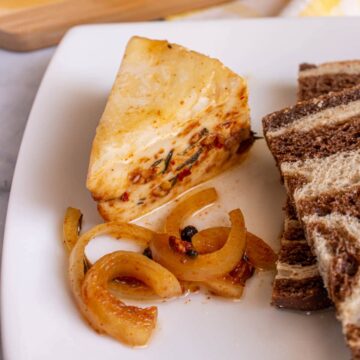
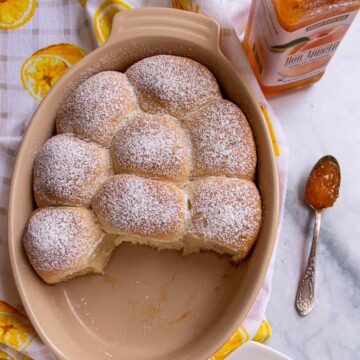

Tess says
Hello! I'm not able to eat dairy and I'm wondering if these can be made with almond milk? Thanks!
Victoria says
Hi Tess,
That's a great question! I'm sure you can replace the milk with almond milk or even water. The flavor may be slightly different but it will still serve its purpose to provide liquid to the dough.
Sandy says
I made these yesterday, I have never worked with yeast so I was little scared. But Nailed it, they were the bomb!!! Everyone was so impressed, I was ‘hero’ for the night! About 10 yrs ago, we moved from Chicago area (where they have great food) to rural Kentucky (where they don’t have great (Diverse)food. We weren’t even able to find frozen dumplings. Oooh if I had only known how easy these were to make I could have been making them for 10 years now!!! My confidence is leveled up…
On to the fruit dumplings!
Thanks
Susan says
Over 20 years ago I moved to another part of the country and there are no bread dumplings anywhere, not in restaurants, not in stores. All these years I've searched for a recipe and tonight I made this one. They turned out exactly what I've searched for. I'm so happy! Three generations of my family completely stuffed themselves on the dumplings. We had breaded pork tenderloin and sweet and sour cabbage to round out a terrific meal. I'll be making these on the regular now. I'm so grateful to you for posting this recipe
Jennifer says
Turned out even better then the Czech restaurant we usually go to. I made them with roast duck and red cabbage (sweet & sour). Thank you so much!
Chris says
Just like I remember as a child…delicious!
Wendy says
This was my first time trying Czech dumplings, I made these last week and loved them! I had so much leftover that I froze them. I would like to use them in a soup but not sure if they are suitable for a soup. Would they just soak up all the broth? Don't want that to happen. I looked and looked and cannot find any mentions of Czech dumplings with soup.... Was thinking I'd either lay them on top like a regular dumpling or maybe squish them up into a ball so they maybe don't soak up as much broth - I don't know, not sure. Any advice on how I could use these in a soup would be appreciated!
Victoria says
Hi Wendy, since these Czech dumplings remind me so much of soft, squishy, spongey bread (and I love dipping bread in soup), I don't see why you couldn't serve them with soup too! I'm not sure I'd float them in the soup right off the bat in case they get extra soggy but maybe try dipping and see how it goes? Maybe start by dipping to see if you like it, and then float one slice and then if you love that, float more 🙂 Enjoy!
Jan klodner (Dallas) says
I found this recipe excellent and easy. I used my KitchenAid mixer with a dough hook. Regular flour and regular salt. Followed your timing for the yeast. Measured flour and salt in the mixer poured the yeast/milk/egg/sugar mixture into the bowl and mixed on low speed. Put it in a bowl covered with a towel and put in a warm oven (not on but warmed up). Took it out kneaded by hand and rolled into an even log about 18-20 inches and let it rise. Repeated that 2 more times. Cooked it covered for 20 minutes. Had 11 for dinner. I have lots left over. Served lightly smoked chicken thighs cooked them with onion carrots and celery seasoned wit caraway seed and some great paprika from Europe. Delicious and thanks!
Nino Vasata says
Made these for Christmas dinner to be served with duck..They were great, but not as light as I remember having them. Still worth the time and effort.
Charlie says
Very clear recipe.
I’m looking forward to trying it as I’d like to make some for a Czech friend who has said how much she liked them when she was growing up in Czech.
I’m having trouble finding quick flour here in UK.
Is it just the low protein and fine nature that’s important or the steaming before it’s dried.
I can find low protein and fine flour relatively easily.
Thanks
Charlie
Victoria says
Hi Charlie! I believe the pre-cooked/dried aspect of this flour is what makes it unique in the recipe, so I'm not sure if another low protein/fine flour would work the same way. If you know of any German or Czech markets in your area you can check those for the corresponding brands listed in the recipe. Amazon UK might also allow you to order one of those brands for delivery. I'm going to reach out to some UK based foodies to see if they have any other suggestions on what you could use. If I have any luck I will let you know!
Charlie says
Thank you.
Victoria says
I've been doing some research! First, I found a website/store in the UK that seems to sell Wondra Flour where you may be able to order it or buy it in person (https://www.tasteamerica.co.uk/our-products/gold-medal-wondra-quick-mixing-all-purpose-flour-13-5-oz-382g.html). Second, I also found a forum that mentioned using Carr's Sauce Flour as a substitute (https://carrsflour.co.uk/product/carrs-sauce-flour-500g/) or Sainsbury's Sauce Flour (https://www.sainsburys.co.uk/gol-ui/product/sainsburys-sauce-flour-500g). I am hopeful that it is a similar product to the other flours listed on my site as substitutes. If you happen to try either of those "sauce flours" for this recipe, could you please let me know how it works? If it works well I'd like to add it to the list of flours that can be used successfully. Thanks!
Kathleen says
Made the dumplings for Thanksgiving. My whole family loved them.
Jordan M says
Great recipe! Much less finicky than other knedlicky recipes I've tried. I will be saving this one and using it very often!!
Clara says
My ex-husband and I used to use a steamer - thin towel in the steamer bowl and steam until cooked. Since we separated, I couldn't remember the recipe, so thank you for sharing this delicious food.
Suzanne says
How much water do I put in the pot with the salt? From the pictures, it doesn’t look like a lot.
Victoria says
Hi Suzanne,
There isn't a specific amount of water I would recommend, but it would really depend on the size and depth of your pot. My widest pot that would fit these is shallower than some of my others so I filled it with enough water so the dumplings could comfortably float and cook, and I could easily flip them. If your pot is deeper you will want to fill it with a bit more water just for ease of access to the dumplings to flip them. With that said, they will float on top so just make sure the water is deep enough so once they expand they have at least a few inches of water beneath them while they cook.
Heather Flosman says
We go to the Czech Republic yearly, as we have family property there. I have made various Czech dishes over the years, but have been intimidated by knedliky. Thank you for this recipe...I made your Czech gulaš and knedlíky. Everything was delicious and VERY authentic. I especially appreciated the tip as to which flour to use. As I am in Canada, I used the Robin Hood Easy Blend and the dumplings were PERFECT!! Again, thank you for such detailed instructions and authentic flavours.
Victoria says
Hi Heather! I’m so glad you enjoyed both of the recipes and the helpful tips. The flavors remind me so much of my travels to the Czech Republic too. I have some other Czech recipes on the site as well, so feel free to check those out if you’d like!
Mitya says
Naive question about "storing" dumplings: Are we supposed to boil the dumpling loaf first and then freeze them? Or do we freeze them in the pre-boiled state?
Victoria says
Hi Mitya,
You should boil the dumplings first and cool them completely. Then wrap them up and freeze them.
Mitya says
Some painfully earned advice for those without much experience using yeast: the key word in this recipe is "warm," as in "milk should be warm to the touch" and "let it rise in a warm spot." (Take a look at the instructions on your yeast package. It probably says the milk should be 100-110°F.) If your milk is just room temperature, if there's a draft in the kitchen, the dough may not rise at all.
Victoria says
Hi Mitya,
Yes, a warmer temperature helps to activate the yeast and allow it to rise in the noted amount of time, HOWEVER yeast can and will rise at low temperatures. Some bread recipes actually require a slow rise (sometimes even in the refrigerator!) overnight. Obviously that's not the case for this particular dumpling recipe, but if you were to leave the dough overnight you would have seen it rise even in a cooler area. I use a slow rise method for my pizza dough all the time, and use cold water and let it sit for about 18 hours at room temperature so it does work if you give it enough time.
Here's a tip I sometimes use if my home is drafty on a particular day. I turn on the oven for just a minute or 2 and then turn it off. It should be very warm but NOT HOT. Then I put my covered bowl of dough in the warm oven and leave it in there (sometimes I even put the oven light on as it radiates a bit of warmth as well). That will make it rise a bit faster by forcing it into a warm space. On a summer day, you should have no trouble putting your bowl near a sunny window or someplace generally warm for it to rise in no time at all. I hope these tips are helpful for your next attempt and working with yeast!
Also make sure you never use milk or water (depending on what the recipe calls for) that is too hot as it can actually kill the yeast. I also always check to make sure my yeast hasn't expired as I have made that mistake once as well! 😀
Jackie says
Does it make a difference if you use whole milk, 2% milk or fat free milk...thank you in advance.
Victoria says
Hi Jackie,
Most baking recipes recommend whole milk because more fat helps to improve flavor and texture in baked goods. With that said realistically I use whatever I have on hand for most of my baking. I used 1% when I made the dumplings pictured here, and they were delicious 🙂 Feel free to use whichever you have in your fridge.